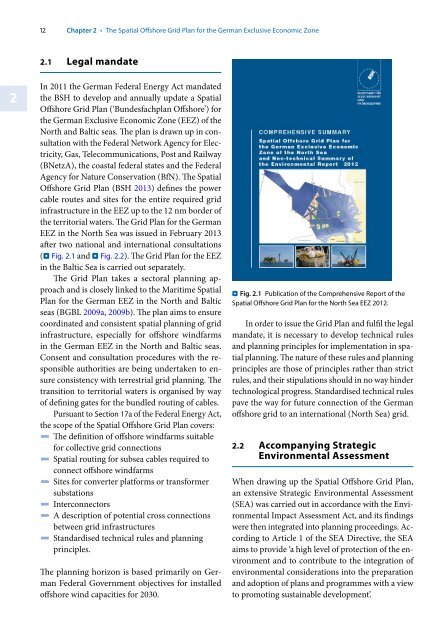bok%3A978-3-658-02462-8.pdf?auth66=1398409209_a0514c2b8e531c058ab8b810a0cad74d&ext=
bok%3A978-3-658-02462-8.pdf?auth66=1398409209_a0514c2b8e531c058ab8b810a0cad74d&ext=
bok%3A978-3-658-02462-8.pdf?auth66=1398409209_a0514c2b8e531c058ab8b810a0cad74d&ext=
- No tags were found...
You also want an ePaper? Increase the reach of your titles
YUMPU automatically turns print PDFs into web optimized ePapers that Google loves.
12Chapter 2 • The Spatial Offshore Grid Plan for the German Exclusive Economic Zone12345678910111213141516171819202.1 Legal mandateIn 2011 the German Federal Energy Act mandatedthe BSH to develop and annually update a SpatialOffshore Grid Plan (‘Bundesfachplan Offshore’) forthe German Exclusive Economic Zone (EEZ) of theNorth and Baltic seas. The plan is drawn up in consultationwith the Federal Network Agency for Electricity,Gas, Telecommunications, Post and Railway(BNetzA), the coastal federal states and the FederalAgency for Nature Conservation (BfN). The SpatialOffshore Grid Plan (BSH 2013) defines the powercable routes and sites for the entire required gridinfrastructure in the EEZ up to the 12 nm border ofthe territorial waters. The Grid Plan for the GermanEEZ in the North Sea was issued in February 2013after two national and international consultations(. Fig. 2.1 and . Fig. 2.2). The Grid Plan for the EEZin the Baltic Sea is carried out separately.The Grid Plan takes a sectoral planning approachand is closely linked to the Maritime SpatialPlan for the German EEZ in the North and Balticseas (BGBL 2009a, 2009b). The plan aims to ensurecoordinated and consistent spatial planning of gridinfrastructure, especially for offshore windfarmsin the German EEZ in the North and Baltic seas.Consent and consultation procedures with the responsibleauthorities are being undertaken to ensureconsistency with terrestrial grid planning. Thetransition to territorial waters is organised by wayof defining gates for the bundled routing of cables.Pursuant to Section 17a of the Federal Energy Act,the scope of the Spatial Offshore Grid Plan covers:The definition of offshore windfarms suitablefor collective grid connectionsSpatial routing for subsea cables required toconnect offshore windfarmsSites for converter platforms or transformersubstationsInterconnectorsA description of potential cross connections-between grid infrastructuresStandardised technical rules and planningprinciples.The planning horizon is based primarily on GermanFederal Government objectives for installedoffshore wind capacities for 2030.. . Fig. 2.1 Publication of the Comprehensive Report of theSpatial Offshore Grid Plan for the North Sea EEZ 2012.In order to issue the Grid Plan and fulfil the legalmandate, it is necessary to develop technical rulesand planning principles for implementation in spatialplanning. The nature of these rules and planningprinciples are those of principles rather than strictrules, and their stipulations should in no way hindertechnological progress. Standardised technical rulespave the way for future connection of the Germanoffshore grid to an international (North Sea) grid.2.2 Accompanying StrategicEnvironmental AssessmentWhen drawing up the Spatial Offshore Grid Plan,an extensive Strategic Environmental Assessment(SEA) was carried out in accordance with the EnvironmentalImpact Assessment Act, and its findingswere then integrated into planning proceedings. Accordingto Article 1 of the SEA Directive, the SEAaims to provide ‘a high level of protection of the environmentand to contribute to the integration ofenvironmental considerations into the preparationand adoption of plans and programmes with a viewto promoting sustainable development’.




